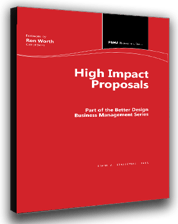 If you’re a professional in an architecture or engineering firm, it’s probably because you love the work. It’s probably not because you love getting the work.
If you’re a professional in an architecture or engineering firm, it’s probably because you love the work. It’s probably not because you love getting the work.
A focused, efficient method for writing winning proposals allows your firm to spend less time winning lucrative contracts and more time doing the work—less time spending money and more time earning it.
Consider these scary statistics: A/E/C firms spend an average of $12,000 to $15,000 to prepare each proposal. Unfortunately, most proposals are bland and ordinary, and only three out of 10 actually bring in work. So every time you write ten proposals, you could be spending over $100,000 for no return at all.
If that’s not frightening enough, consider this: Reviewers at your potential client’s firm will spend less than a minute flipping through your carefully prepared proposal to get a first impression of your firm and your ideas. If they decide to read the whole proposal, they’ll spend only 25 to 35 minutes on the document that took you hours, maybe weeks, to create.
What to do?
Learn to create stand-out proposals that separate you from the thousands of look-alikes submitted to clients every year. Keep your proposal on the top of the stack. Make your proposal special—focused, readable, convincing—in both content and appearance. Re-design your proposal-writing process to make the best use of the time and talent of the people in your firm. Stop spending money chasing business that you won’t get, that might not even be appropriate for your firm.
Stand-Out Proposals vs. Also-Rans
A winning proposal focuses on the needs and concerns of the client... not those of your firm. You need to know your potential clients very well in order to identify their real issues (not always those stated in the RFP), and counter those with the benefits you provide that will solve their problems.
A winning proposal shows that you understand the big picture — your clients’ overall business and the competitive world in which they operate. It shows how you will add value to their operation.
The content presents your clear, logical, technical approach to their project, and shows that your plan will work. It presents an attractive fee in relation to the value you will add. It shows a clear link between the elements of the proposal and the evaluation criteria.
A well-written winning proposal demonstrates your understanding of the client’s needs and desires. It restates the criteria for selection and shows that your firm meets those criteria. It demonstrates the competencies and experience that your project team brings to this specific project. It’s readable, concise, attractive, and well-organized. Boilerplate is used creatively, if at all.
The also-ran proposals, the ones that find their way to the bottom of the stack, tend to be too generic: they don’t reflect the client’s specific needs, wants, or concerns. They focus on the features offered by the A/E/C firms instead of the benefits those features could provide.
Losing proposals are often packed with statistics and exhibits that are not relevant to the project, or padded with good-looking boilerplate that says little or nothing relating to the client’s concerns at the moment. Losing proposals are sometimes disorganized, hard to read, irrelevant, incomplete, too long, or too short.
A winning proposal...is a project blueprint and therefore specific to the individual client and their particular project needs. Problems during the project concerning budget, schedule, and scope of work often relate to deficiencies in the proposal.
 This article is an excerpt from High Impact Proposals, a best seller from PSMJ Founder and CEO Frank A. Stasiowski, FAIA. In today’s hyper-competitive landscape, you always need to be thinking about effective strategies and tactics to boost your proposal hit rate. As a busy architecture or engineering firm leader, you can’t rest on what has worked in the past and you certainly can’t leave anything to chance. You need the inside scoop. You need the proven A/E/C-specific tips to get your hit rate going nowhere but up. Download a free chapter of High Impact Proposals here.
This article is an excerpt from High Impact Proposals, a best seller from PSMJ Founder and CEO Frank A. Stasiowski, FAIA. In today’s hyper-competitive landscape, you always need to be thinking about effective strategies and tactics to boost your proposal hit rate. As a busy architecture or engineering firm leader, you can’t rest on what has worked in the past and you certainly can’t leave anything to chance. You need the inside scoop. You need the proven A/E/C-specific tips to get your hit rate going nowhere but up. Download a free chapter of High Impact Proposals here.

You also might be interested in these blog posts by Frank A. Stasiowski:
Why Value Pricing is the Only Way to Survive
Classic Mistakes: 3 Steps To Lose a Client
Client Service Strategy to Guarantee Repeat Clients
How to Maximize Profits With Value Pricing
 If you’re a professional in an architecture or engineering firm, it’s probably because you love the work. It’s probably not because you love getting the work.
If you’re a professional in an architecture or engineering firm, it’s probably because you love the work. It’s probably not because you love getting the work.



